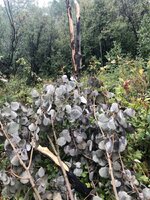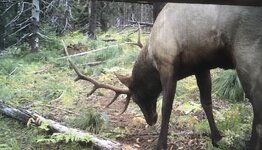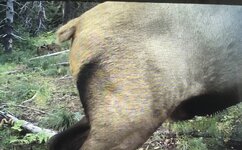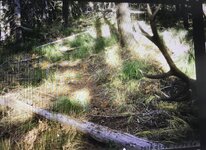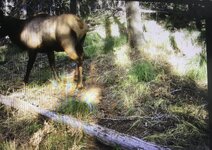When bulls make a rub is it a one and done kind of deal or will they return every so often? I'm used to whitetails returning several times in a few weeks. I've found a few areas that were loaded with rubs but sign was a week or two old. I dearly wanted to hunt the area for my entire hunt but the elk just weren't there at the time so I moved on. I'm a fairly new elk hunter but I'm 2/3 on elk hunts so far so I feel like I'm headed in the right direction. Time on the mountain is limited so I'm constantly trying to learn all I can! Thanks and good luck this season!
Navigation
Install the app
How to install the app on iOS
Follow along with the video below to see how to install our site as a web app on your home screen.
Note: This feature may not be available in some browsers.
More options
Style variation
You are using an out of date browser. It may not display this or other websites correctly.
You should upgrade or use an alternative browser.
You should upgrade or use an alternative browser.
Elk rubs
- Thread starter Npike4040
- Start date
NMBigGame
FNG
Replying to get on this tread.
From what I've heard, primarily bulls will not be with cows until the rut. In the pre-rut and before they will rub. Sounds like you're describing their prerut location and they had moved on.
From what I've heard, primarily bulls will not be with cows until the rut. In the pre-rut and before they will rub. Sounds like you're describing their prerut location and they had moved on.
Would not recommend sitting by a rub unless you are watching the bull making it. They will not come back to a rub to check it. If you find an area with a history of rubs that could be a place they frequent during their routes around a mountain. I use rubs to tell me if a bull may be close as you can smell it from a good distance if so and also how many bulls are in the area. Lastly, if it is on a Big tree the bull is good size Also, elk cover and roam a vast area typically so you don’t typically want to hunt them like whitetails for continued success. I have cams of bulls covering 6-10 miles on a topo looking for cows or just doing bull stuff
Also, elk cover and roam a vast area typically so you don’t typically want to hunt them like whitetails for continued success. I have cams of bulls covering 6-10 miles on a topo looking for cows or just doing bull stuff
BBob
WKR
Elk rubs to me are transitory. They rub where and when they feel like it or where they happen to be in the heat of the moment. I’m talking during the rut rubs. You’ll have pre rut rubbing to remove velvet and those could be many many miles away from where that bull it’s now. It’s been documented in Arizona and New Mexico that bulls have moved 25-30 miles to rut.
Jaquomo
WKR
- Joined
- Apr 27, 2012
- Messages
- 432
What Ross said. Also, an area with a lot of rubs is probably a bedding area, which you might want to avoid anyway. I've watched many, many bulls rub the heck out of trees for whatever eeason trips their trigger, then move on and end up in the next drainage over.
farmermail
Lil-Rokslider
Early AugustWhat dates do bulls typically lose velvet?
ElDiablito
WKR
- Joined
- Mar 2, 2022
- Messages
- 1,494
Where I hunt in central Colorado, the bulls on my cameras usually rub 7-10 Aug.What dates do bulls typically lose velvet?
Ross pretty well covered it. i would add a couple things.
First, if it's only one ore two in the area. it's a travel spot. If you move up the mountain after the rut you may find bedding/ recovery area. possibly good after rut during rifle.
If you find an area that is tore to crap and has what appears to be several years worth of rubs, this is his living area.
An old bull will return to this area with a few cows. usually higher then the rubs.
If there are scrapes with the rubs this is part of a loop. just like whitetail. bigger scale of loop.
If there are a series of rubs and running up the mountain, then hunt other side of mountain. If rubs are running across the mountain then hunt adjoining drainages.
Closer you get to end of rut more likely to find bulls returning to/through these areas.
Find cows in august. plot thier locations with locations of rubs and you will get a good idea of how elk are traveling in and through an area.
Keep in mind not are bulls are created equal. Different age class bulls travel different distances. from birth to 4 or 5 a bull will stick sort of close to cows all year. From 6-9 they will start hanging further back. Once they hit 10 and beyond they will start traveling less and less distance from winter range.
There is pages and pages that could be written on their travel stuff.
A 12 year old bull often times will not leave winter range. If he does its a 5-12 mile travel circle just to keep predators at bay. He will often be found with 3 or 4 cows traveling with him. those cows will stick with him all year minus calving stuff. A bull that old is perfectly content not fighting and just waiting for those few cows to come in.
If cows are traveling 30 or 40 miles to summer range from winter range a 6-10 year bull will probably travel half that distance at a much slower pace until July. Then start cutting distance in August.
Younger bulls can be found in bachelor groups either real close to cow areas or with older bulls. These are the bulls you will see chasing cows very early in the rut. They will move to cows quicker then older bulls. These are the bulls that would go from rag horn to 340 ish antler size. Not trying to equate antler size to age class just visual reference.
Of course there are exceptions this is not hard and fast. General rule of thumb to determine what age class of bull you are after at what time of year.
Every area of country is slightly different.
Some old bulls stick close to dreading ground. Lot of times breading ground and calving ground are same area.
So if you know where winter range is. Then find calving ground in june. Then find cows in middle august. You know the travel route of herd. Then rub stuff can help determine bull patterns.
rubs by themselves are useless. Put it all together and you can paint a pretty good picture of what, when and where they like to meander.
First, if it's only one ore two in the area. it's a travel spot. If you move up the mountain after the rut you may find bedding/ recovery area. possibly good after rut during rifle.
If you find an area that is tore to crap and has what appears to be several years worth of rubs, this is his living area.
An old bull will return to this area with a few cows. usually higher then the rubs.
If there are scrapes with the rubs this is part of a loop. just like whitetail. bigger scale of loop.
If there are a series of rubs and running up the mountain, then hunt other side of mountain. If rubs are running across the mountain then hunt adjoining drainages.
Closer you get to end of rut more likely to find bulls returning to/through these areas.
Find cows in august. plot thier locations with locations of rubs and you will get a good idea of how elk are traveling in and through an area.
Keep in mind not are bulls are created equal. Different age class bulls travel different distances. from birth to 4 or 5 a bull will stick sort of close to cows all year. From 6-9 they will start hanging further back. Once they hit 10 and beyond they will start traveling less and less distance from winter range.
There is pages and pages that could be written on their travel stuff.
A 12 year old bull often times will not leave winter range. If he does its a 5-12 mile travel circle just to keep predators at bay. He will often be found with 3 or 4 cows traveling with him. those cows will stick with him all year minus calving stuff. A bull that old is perfectly content not fighting and just waiting for those few cows to come in.
If cows are traveling 30 or 40 miles to summer range from winter range a 6-10 year bull will probably travel half that distance at a much slower pace until July. Then start cutting distance in August.
Younger bulls can be found in bachelor groups either real close to cow areas or with older bulls. These are the bulls you will see chasing cows very early in the rut. They will move to cows quicker then older bulls. These are the bulls that would go from rag horn to 340 ish antler size. Not trying to equate antler size to age class just visual reference.
Of course there are exceptions this is not hard and fast. General rule of thumb to determine what age class of bull you are after at what time of year.
Every area of country is slightly different.
Some old bulls stick close to dreading ground. Lot of times breading ground and calving ground are same area.
So if you know where winter range is. Then find calving ground in june. Then find cows in middle august. You know the travel route of herd. Then rub stuff can help determine bull patterns.
rubs by themselves are useless. Put it all together and you can paint a pretty good picture of what, when and where they like to meander.
Gerbdog
WKR
Absolutely. Last year alone i can think of 3 encounters that came the rest of the way in due to raking after they got hung up. Actually the bull i shot was one of them.I'm happy to hear most of you don't hun rub areas, lol.
Every raked in a bull while calling?
11boo
WKR
taskswap
WKR
- Joined
- Oct 6, 2021
- Messages
- 878
It's because elk aren't protective of territory, like bears or dogs. They're protective of their harems, and only during the rut. So the rubs help them get the velvet off (it's assumed to be very itchy) and may leave some scent markers, but they don't have any drive to "maintain" or monitor the rubs.
I run a lot of cams and have 40 yrs history in several drainages. Ran this cam in a place I shot my first elk in the 80s and several since. There are many rub trees through the decades and wanted to catch a bull raking a tree. I was off by a few feet in doing so. The first bull raked a sizable tree the last week of September and was shot 5 miles away the first week of rifle 2 weeks later chasing cows. The next yr another bull came by that 1 yr raked tree and I missed him by 16 hours. This bull is still alive and one I’m chasing this yr. The body shot is him pushing on this big tree. Come late September they will do a lot of raking either polishing or the mock battle stuff. Have shot several bulls with aggressive raking tactics. One has kicker on left the other the right.
Attachments
I view it as subjective. If I see lots of fresh rubs that kind of surround an area, it's indicator a bull is in the area and is marking his zone. It needs to be fresh and I hope I can still smell the bull. I like to spend more time in an area where there are multiple rubs, from multiple years that also have lots of other sign near there.
Sent from my SM-S918U using Tapatalk
Sent from my SM-S918U using Tapatalk
Glad you posted this so I can get a good visual on what a run actually looks like. I’m a brand new elk hunter and never put much thought into whitetail rubs so good to read all this thread!It’s a good sign is all that they were there . What’s to come back to lol. Tore this one down.View attachment 723886
Similar threads
Featured Video
Latest Articles
- TT#64 Josh Boyd Elk Hunting Strategies for Every Season
- Aaron Davidson of Gunwerks
- TT#63 Dirk Durham’s Art of Elk Calling
- BIG Buck Stories with the Dirty Giants Podcast
- TT#62 Brian Barney Hunting Bulls without Calling
- Hoyt Alpha AX-2 SD Review
- Kuiu Kenai vs Outdoor Vitals Vario Hooded Jacket Review
- Hoyt RX-9 Ultra Review
- Hunting Vampire Bucks & Building an Optics Kit
- Darton Sequel ST2 35 Review

